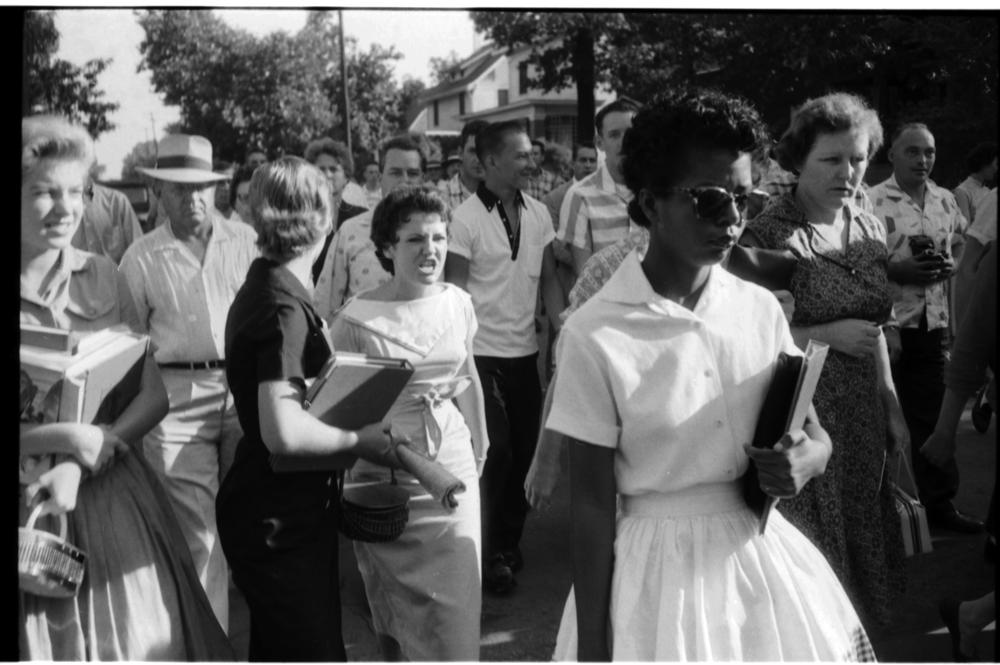One of the few photographs where I appear with my hair combed was taken in September 1957. The biography of my hair is its legend and rescue. It might be strange that this self-portrait of me was captured by another person at the main entrance of the Little Rock Central High School, in Arkansas, long before I was born, and that it has become a symbol in the Civil Rights struggle in the United States of America. Even stranger and more difficult to explain is the circumstance in which I am, at the same time, all of the people in that picture.
It’s not that this photograph symbolizes a particular episode in my life. It’s an X-ray of my soul. My soul is the misleadingly impassive image of Elizabeth Eckford in the foreground and the crowd’s ruthless hatred as they pass her in the background. My fear is completely centred on the contraction of the muscles in my hand and forearm, holding my notebook against my torso, fearing to let it fall and be swallowed up by all those girls. All of the violence in the photograph converges on my clenched teeth, as I pursue someone unknown. I am the curious people that follow and want to enjoy themselves a little bit. This is a portrait of self-persecution, and the daily attempt to be indifferent to it.
The photograph of Little Rock makes me think of Monica from ninth grade, whose face was marked by late complications of chickenpox, and who declared she’d prefer to abort than have a black child; or of Sofia from Central, where I learned to like coffee – that sour-faced grump from the afternoon shift who was always yawning behind the counter, and who, after serving all the other customers with an expression of nausea, gave me a segregationist’s gaze as she brought me the bill. It’s mysterious that I don’t recognize their faces in the white girls in the photograph. I don’t recognize them because the white girls in the photograph are nothing less than me in miniature size, little rock, mulata das pedras. I am the escape and the pursuit, disfigured, disfiguring myself.
This image captures the supremacist in me, the aggressive spirit that ruins my days, even though nothing or no one assaults or has assaulted me from the outside; the supremacist implicit in my reticent shying away from the hurt of so many other heads of curly hair that I pass in Lisbon, their pain much more justified than my own. All forms of shyness have always been a natural privilege to me, rather than a reaction to circumstance. That supremacist is the idea, in those brothers and sisters of mine, of shyness (which no one understands) being an encumbrance that they should purge as they try to find in their interaction with the world a perfect mixture of disdain, meekness and expansiveness.
It’s a whisper: divert your gaze from the police, don’t complain on the streets; don’t occupy the reserved seats on empty buses; get out of the way; in important matters change your accent on the telephone; disappear from the hallways, really disappear between your apologies and your shadow of silence; leave nothing but the slippery surface as a vestige of yourself; forget the History of Hair, even though there is no real trouble out here – none at all.
Although that supremacist seems like he should only belong to my pacifistic walking in the footsteps of Elizabeth, he doesn’t. He does not fit into any known definition. He subsists even when nothing bellows. He was very much alive in my grandfather Castro, who hollered against the ‘niggers’ on the bus. He is very much alive in the first reaction all hairdressers, black or white, have to the texture of my hair. He is not a pretext for definition, but an unchallenged narrator. I listen to him distinctively. He is the italics in the conversations at the coffee house around the corner, emphases that shock me as if they were about me. ‘I had to throw out my black skirt: it got ruined in the machine’; ‘look at the black smoke coming from that motorbike,’ say the old women over the hubbub of saucers, cups, forks, knives, change. I look over my shoulder, searching for evidence; the conversation continues. It has nothing to do with me. The angry girls in the photograph are that nervous fear (of which I am ashamed) when a black man on the train answers the phone and talks loudly. ‘Shush: speak softly’, they tell me, I tell him, I tell myself, ‘be careful with people’. They pursue me in the mirror when I get ready to go out, making me believe the pair of gold hoop earrings that I never end up wearing look ethnic, and for that reason vulgar. They make me prepare for insult each time I go out, even though in the streets there are only dogs barking in the rain. I mobilise myself every day for what is never more than a multitude of clouds, an infamous mockery of the history of race, my fears no more than quixotic. These angry girls, their voices, made me into the ‘quite classic’ type of girl that I play on the street. Her italics have become nature: relaxed hair.
The above is taken from Esse Cabelo (That Hair), published in the Portuguese by Teorema
Photograph © Will Counts Collection: Indiana University Archives








